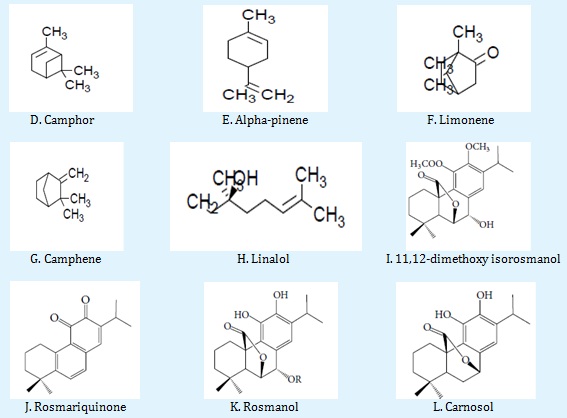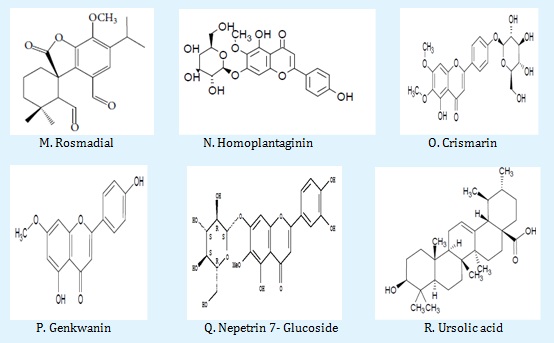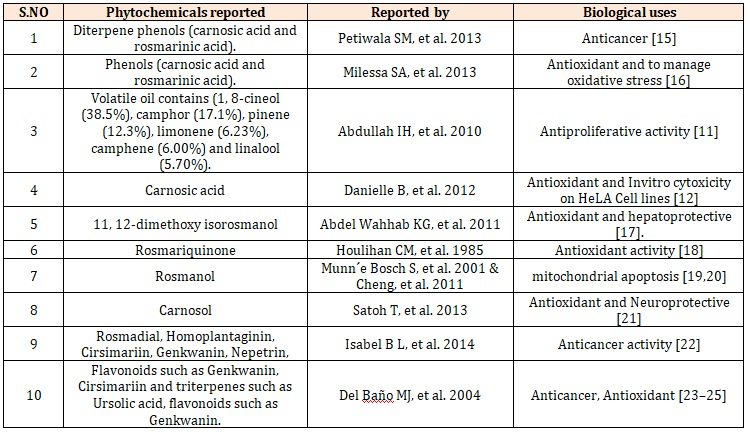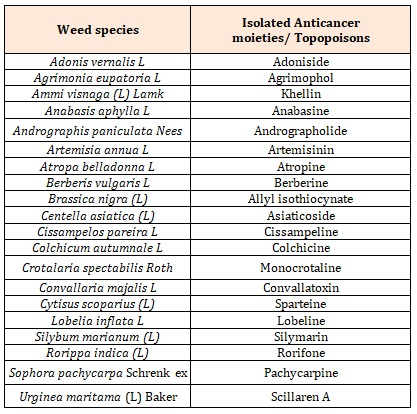
Citation: Chaitanya MVNL, et al. A Short Review: Importance of Rosemarinus Officinalis as a Living Library for the Discovery of Human Topo Poisons. Int J Pharmacogn Chinese Med 2017, 1(3): 000113.
*Corresponding author: Chaitanya MVNL, Lecturer, Department of Pharmacognosy & Phytopharmacy; JSS College of Pharmacy (A Constituent College of Jagadguru Shivarathreeshwara University), Post box no: 20, The Nilgiris-643001, Tamilnadu, India, Tel: +917867912811; Email: chaitanya.phyto@gmail.com, chaitanya.phyto@jssuni.edu.in
The clinical efficacy of the current anticancer agents that are being in use was reduced due to reappearance of carcinoma and severe adverse effects of chemotherapy agents. Hence there is a need to discover novel anticancer molecules which is possible from nature only. The dual topo drugging is an important phenonomena in the cancer treatment. Even though many synthetic drugs as topo- poisons have been developed and used in the clinical trials, but having many challenges and are not successful due to cancer resistance. Now days, Rosemarinus Officinalis belongs to the family lamiaceae got recognized globally for its potent anticancer properties. Traditionally this plant is useful in treatment of many aliments like antiseptic, woundhealing , carminative and as brain tonic , hence the researchers focused this plant for anticancer and memory enhancing capabilities . This herb is reported for its important secondary metabolite known as rosmarinic acid .However this medicinal herb is not explored phytochemically and the molecular mechanism of its potent anticancer property is still under progress. As the entire pharmaceutical industries are looking for potent dual new human topoisomerase inhibitors, this herb may be an extensive source for discovery of topopoison drugs or leads. Hence an extensive research is under progress from our team on this herb. The current short review highlights the phytochemical importance of Rosemarinus Officinalis in treating cancer.
Keywords: Rosemarinus Officinalis; Anticancer; Discovery of Topopoisons
Rosmarinus officinalis, commonly known as rosemary belongs to family lamiaceae (having 236 genuses with more than 7000 species), is a generally erect, rounded, evergreen shrub with aromatic, needle-like, gray-green leaves and tiny, two-lipped, pale blue to white flowers. It typically grows to 4-6’ tall in areas where it is winter hardy. The intensely fragrant foliage of this shrub is commonly harvested for a variety of purposes including culinary flavorings, toiletries and sachets. These plants also add excellent ornamental value to borders, herb gardens, patio areas and foundations both when grown in the ground and/or as container plants which are often brought indoors for overwintering. Rosemary is native to dry scrub and rocky places in the Mediterranean areas of southern Europe to western Asia. Gray-green, linear, needle-like leaves (to 1.5” long) are closely spaced on the stems and are very aromatic with a strong flavor. Tiny, two-lipped flowers bloom in axillary clusters along the shoots of the prior year’s growth. Where grown outdoors in USDA Zones 8-11, flowers typically bloom from January to April [1,2].
Cancer and its Global ScenarioCancer is defined as a group of diseases characterized by the uncontrolled growth and spread of abnormal cells [2]. Globally, cancer is a major health disaster and is to believe as a major reason of death in the next few years. As per the American Cancer Society, it is estimated that overall cancer death rate was decreased from 215.1 (per 100,000 populations) in 1991 to 168.7 in 2011 [3].
Therefore, the dual topo drugging is an important phenonomena in the cancer treatment. Even though many synthetic drugs as topo-poisons have been developed and used in the clinical trials, but having many challenges and are not successful due to cancer resistance. Hence there is a current demand for the discovery of new human dual topo-poisons I & II, which is possible from pharmacologically unexplored plants [4-6].
Hence the review is trying to fill the neglected gap between Rosmarinus officinalis and its reported phytochemicals. These phytochemicals have to prove for their molecular mechanism studies as human topoisomerase inhibitors I & II.
Need for New Natural Anticancer DrugsDue to increase in resistance of mammalian tumors towards existed anticancer drugs, there is always a need to develop alternative novel drugs and this is possible only from alternative natural sources like plants, algae and microbes. These alternative approaches have been started with the discovery of vinca alkaloids towards treatment of various types of cancer. Various secondary metabolites like fatty acids, polyphenols, alkaloids, saponins and flavanoids were proved to be as novel alternative anticancer agents and gained the interest of many researchers over the globe to discover novel drugs or leads from the plants containing these secondary metabolites. The present review highlights a plethora of current trends involved in the discovery of anticancer drugs from the plants and algae containing these secondary metabolites that can be use as human dual Topopoisons I & II agents [7].
Even though there is lot of technological and social development, cancer became one of the important causes of human death. Despite of remarkable success in development of novel antitumor compounds, severe toxicity and resistance is the major drawback in treatment of cancer worldwide hence the globe is looking for an alternate novel drugs discovery and latest mechanisms in treatment of cancer disease [8,9].
Drugging Topo-IsomerasesTopoisomerases are important current targets in cancer treatment and plays an important role in DNA replication, transcription, chromosome segregation and recombination. There are two major types of topoisomerases i.e type I, which helps in making cuts in single strand DNA and type II makes cut in double strand DNA These topoisomerases controls DNA super coiling and entanglements and are essential during transcription and replication. These are the most important targets for the anticancer and antibacterial drugs. These enzymes are present in all eukaryotes and eubacteria. Humans have six types of topoisomerases and bacteria contain only four types. The topoisomerase inhibitors or Topopoisons are effective chemotherapies and should suggest to patients who can benefit from these. However these topoisomerase inhibitors are proved to be clinically significant only in few patients as there are many other factors come in to picture in treatment of cancer. However dual topoisomerase inhibitors are essential drugs and are in current demand towards treatment of cancer [10].
Traditional UsesEven Rosemary is being used in various traditional medicines by the ethnic groups over the globe for treating various diseases. In traditional medicine, extracts and essential oil from flowers and leaves are used in the belief they may be useful to treat a variety of disorders. Rosemary essential oil contains 10-20% camphor though the chemical composition can vary greatly between different samples, according to in vitro studies.
Rosemary herbs have been widely used in the traditional medicine and cosmetics. In Pakistan They are also used as flavouring agents in foods. Rosmarinus officinalis essential oil is also using for its powerful antibacterial, cytotoxic, antimutagenic, antioxidant, antiphlogistic and chemopreventive properties [11]. In South Africa , the tribal people uses this herb decoction to treat ulcers and necrosis, A team of researchers from university of Pretoria taken this herb for extensive invitro cytotoxic studies on this herb [12].
In Algeria, the Rosemary is being use as culinary spice and medicinal herb, has been widely used in folk medicine to treat numerous ailments. Traditionally, it was used for relieving renal colic, asthma, spasmogenic disorders, peptic ulcer, inflammatory diseases, hepatotoxicity, atherosclerosis, ischaemic heart disease, cataract, and poor sperm motility. A population-based study has suggested that an overall risk reduction in cancer incidence is correlated with patients consuming herbs including rosemary [13]. In south west Algeria, the traditional healers uses the rosemary leaves decoction for the treatment of cough and stomach [14].
Phytochemicals and Anticancer Properties of Rosmarinus officinalisVarious phytochemicals have been isolated from Rosmarinus officinalis against various activities including main activity as an anticancer property. The various phytochemicals and its reported anticancer activity were given in the following Table 1.
However, in fact of various secondary metabolites discovered from Rosmarinus officinalis, the anticancer molecular mechanism on this plant and discovered moieties is incomplete. Not even single research has been targeted to prove the human topopoison activity on these moieties isolated from this plant , Still many unknown moieties may exist in this plant further have to explore which can be serve as potent human topopoison leads.
With the implementation of latest chromatographic techniques & in-silico designing tools, the natural product research towards discovery of anticancer molecules had been easier and faster. These tools in herbal medicine research as a means: to seek out potential mechanisms of action of their constituents; to identify putative new leads for drugs; and to summarize and/or visualize the complex herbal medicine. Knowledge of the computational specialist is essential in guiding decisions made here, and it is imperative that the tools should be applied in herbal medicine research through close collaboration between computational specialists and natural product research.
The topoisomerases are the cellular enzymes that change the topological state of the DNA. Even though many synthetic drugs as topo- poisons have been developed and used in the clinical trials, but having severe side effects and not successful. Therefore, there is a need for the development of novel plant derived natural drugs and their analogs which may serve as lead molecules having topo enzyme inhibitory activity [26].
Reported Topo-poisonsThere is a lot of literature proving that these plants are storehouses for unique secondary metabolites and proved to be promising for drug discovery [27]. Even various Topopoisons leads ( A lead is a molecule having activity but clinically insignificant activity , further useful in discovery of new structures by modifying the existed structures using structure activity relationship), However not even a single attempt was made in the past by the researchers in order to prove the topopoison activity of Rosmarinus officinalis. The various Topopoisons discovered from various plants was represented in the following Table 2.
Targeting Topo I & Topo II EnzymesBy keeping all the above facts, the molecular docking studies can be performed on these reported leads inorder to know their human topopison I & II activity. This can be carry out by taking these lead structures into the catalytic domain of Human topo isomerases I (PDB ID: 1K4T at 2.10 A°, PDB ID: 3AL2 at 2.0 A0) and Human topo isomerases II (PDB ID: 1ZXN at 2.51 A°, PDB ID: 3QX3 at 2.16 A°). The docking studies will be between the selected isomerase proteins and energetically minimized chemical compounds using GLIDE Program (Grid Based Ligand Docking from Energetics, from Schrodinger 9.9/2014-3 suite). The Epik studies can also be carry out for the selected compounds using the same software in order to know their pKa values. The ADMET studies can also be carried out using QikProp. The binding free energy of inhibitors in the catalytic domain enzyme (1K4T) can be done by Molecular Mechanics/Generalized Born Surface Area (MM/GBSA) VSGB 2.0 method. The calculated inhibitorenzyme complex was relaxed using the local optimization feature in prime, version 4.1, Schrödinger 2014, and the energies of the system were calculated using the VSGB 2.0 (salvation) [28].
ConclusionThe current review article focused on the importance of Rosemarinus Officinalis as an important store house of anticancer leads. However the current review also focuses the lacuna that very less research has been carried out on this plant and no trail have been attempt to prove the topo poison activity on these moieties discovered from this herb. Now days the rosemary got its recognition over all the globe for its anticancer properties. Hence the researchers are focusing on this plant to prove the topopoison mechanism on this reported leads and also trying to discover some new potent moieties from this herb which may serve as an important human dual Topopoisons I & II leads or drugs. The researchers as an initial part of their research trying to express the importance and lacunas of anticancer properties of Rosemarinus Officinalis.
AcknowledgementThe authors greatly acknowledge Jagadguru Shivarathreeshwara University, Mysuru and JSS College of Pharmacy, Rocklands, Ooty for providing the necessary facilities.



Figure 1: Secondary Metabolites isolated from Rosmarinus officinalis.

Table 1: Phytochemicals and its reported anticancer activity.

Table 2: Various reported topopoison leads from different Plants.